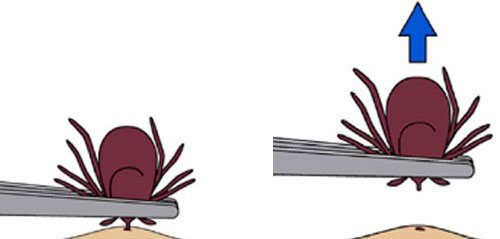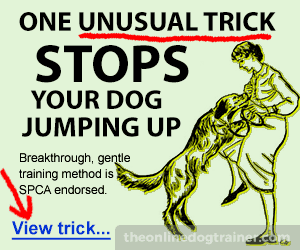Ticks and Your Dog
By The US Center for Disease Control

Preventing ticks on your pets
Dogs are very susceptible to tick bites and tickborne diseases. Vaccines are not available for all the tickborne diseases that dogs can get, and they don’t keep the dogs from bringing ticks into your home. For these reasons, it’s important to use a tick preventive product on your dog.
Tick bites on dogs may be hard to detect. Signs of tickborne disease may not appear for 7-21 days or longer after a tick bite, so watch your dog closely for changes in behavior or appetite if you suspect that your pet has been bitten by a tick.
Click here to fix your dog's behavior problem and get started with dog obedience training.
To reduce the chances that a tick will transmit disease to you or your pets:
- Check your pets for ticks daily, especially after they spend time outdoors.
- If you find a tick on your dog, remove it right away.
- Ask your veterinarian to conduct a tick check at each exam.
- Talk to your veterinarian about tickborne diseases in your area.
- Reduce tick habitat in your yard.
- Talk with your veterinarian about using tick preventives on your pet.
Note: Cats are extremely sensitive to a variety of chemicals. Do not apply any insecticides, acaricides, or repellents to your cats without first consulting your veterinarian!
Kill Ticks on Dogs
A pesticide product that kills ticks is known as an acaricide. Acaricides that can be used on dogs include dusts, impregnated collars, sprays, or topical treatments. Some acaricides kill the tick on contact. Others may be absorbed into the bloodstream of a dog and kill ticks that attach and feed.
Pros:
- Helps to reduce the number of ticks in the environment
- Prevents tickborne disease
Cons:
- Tick bites can cause a painful wound and may become infected.
- When bitten, a dog may become infected with a number of diseases. This depends on the type of tick, which diseases it is carrying (if any), and how quickly a product kills the feeding tick.
Examples of topically applied products (active ingredients):
- Fipronil
- Pyrethroids (permethrin, etc.)
- Amitraz
Repel Ticks on Dogs
A repellent product may prevent the tick from coming into contact with an animal at all or have anti-feeding effects once the tick comes into contact with the chemical, thus preventing a bite.
Pros:
- Prevents bite wounds and possible resulting infections
- Prevents tickborne disease
Cons:
- Will not reduce the number of ticks in the environment (doesn’t kill ticks)
Examples of topically applied products (active ingredients):
- Pyrethroids (permethrin, etc.)
Reference to any commercial entity or product or service on this page should not be construed as an endorsement by the Government of the company, its products, or its services.
Tick Removal
If you find a tick attached to your dog’s skin, there’s no need to panic. There are several tick removal devices on the market, but a plain set of fine-tipped tweezers will remove a tick quite effectively.
How to remove a tick
Use fine-tipped tweezers to grasp the tick as close to the skin’s surface as possible. Pull upward with steady, even pressure. Don’t twist or jerk the tick; this can cause the mouth-parts to break off and remain in the skin. If this happens, remove the mouth-parts with tweezers. If you are unable to remove the mouth easily with clean tweezers, leave it alone and let the skin heal.
After removing the tick, thoroughly clean the bite area and your hands with rubbing alcohol, an iodine scrub, or soap and water.
Dispose of a live tick by submersing it in alcohol, placing it in a sealed bag/container, wrapping it tightly in tape, or flushing it down the toilet. Never crush a tick with your fingers.
Avoid folklore remedies such as “painting” the tick with nail polish or petroleum jelly, or using heat to make the tick detach from the skin. Your goal is to remove the tick as quickly as possible—not waiting for it to detach.
Follow-up
If your dog develops a rash or fever within several weeks of removing a tick, see your veterinarian. Be sure to tell the vet about the recent tick bite, when the bite occurred, and where your dog most likely acquired the tick.
Preventing ticks in the yard
Apply Pesticides Outdoors to Control Ticks
Use of acaricides (tick pesticides) can reduce the number of ticks in treated areas of your yard. However, you should not rely on spraying to reduce your risk of infection.
If you have health concerns about applying acaricides:
- Check with local health or agricultural officials about the best time to apply acaricide in your area.
- Identify rules and regulations related to pesticide application on residential properties (Environmental Protection Agency and your state determine the availability of pesticides).
- Consider using a professional pesticide company to apply pesticides at your home.
Here are some simple landscaping techniques that can help reduce tick populations:
- Remove leaf litter.
- Clear tall grasses and brush around homes and at the edge of lawns.
- Place a 3-ft wide barrier of wood chips or gravel between lawns and wooded areas to restrict tick migration into recreational areas.
- Mow the lawn frequently.
- Stack wood neatly and in a dry area (discourages rodents).
- Keep playground equipment, decks, and patios away from yard edges and trees.
- Discourage unwelcome animals (such as deer, raccoons, and stray dogs) from entering your yard by constructing fences.
- Remove old furniture, mattresses, or trash from the yard that may give ticks a place to hide.
Click here to fix your dog's behavior problem and get started with dog obedience training.







